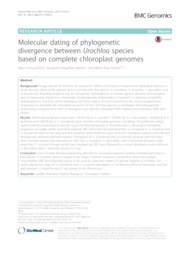Molecular dating of phylogenetic divergence between Urochloa species based on complete chloroplast genomes.
Molecular dating of phylogenetic divergence between Urochloa species based on complete chloroplast genomes.
Autoria: PESSOA FILHO, M. A. C. de P.; MARTINS, A. M.; FERREIRA, M. E.
Resumo: Abstract: Background: Forage species of Urochloa are planted in millions of hectares of tropical and subtropical pastures in South America. Most of the planted area is covered with four species (U. ruziziensis, U. brizantha, U. decumbens and U. humidicola). Breeding programs rely on interspecific hybridizations to increase genetic diversity and introgress traits of agronomic importance. Knowledge of phylogenetic relationships is important to optimize compatible hybridizations in Urochloa, where phylogeny has been subject of some controversy. We used next-generation sequencing to assemble the chloroplast genomes of four Urochloa species to investigate their phylogenetic relationships, compute their times of divergence and identify chloroplast DNA markers (microsatellites, SNPs and InDels). Results: Whole plastid genome sizes were 138,765 bp in U. ruziziensis, 138,945 bp in U. decumbens, 138,946 bp in U. brizantha and 138,976 bp in U. humidicola. Each Urochloa chloroplast genome contained 130 predicted coding regions and structural features that are typical of Panicoid grasses. U. brizantha and U. decumbens chloroplast sequences are highly similar and show reduced SNP, InDel and SSR polymorphism as compared to U. ruziziensis and U. humidicola. Most of the structural and sequence polymorphisms were located in intergenic regions, and reflected phylogenetic distances between species. Divergence of U. humidicola from a common ancestor with the three other Urochloa species was estimated at 9.46 mya. U. ruziziensis, U. decumbens, and U. brizantha formed a clade where the U. ruziziensis lineage would have diverged by 5.67 mya, followed by a recent divergence event between U. decumbens and U. brizantha around 1.6 mya. Conclusion: Low-coverage Illumina sequencing allowed the successful sequence analysis of plastid genomes in four species of Urochloa used as forages in the tropics. Pairwise sequence comparisons detected multiple microsatellite, SNP and InDel sites prone to be used as molecular markers in genetic analysis of Urochloa. Our results placed the origin of U. humidicola and U. ruziziensis divergence in the Miocene-Pliocene boundary, and the split between U. brizantha and U. decumbens in the Pleistocene.
Ano de publicação: 2017
Tipo de publicação: Artigo de periódico
Unidade: Embrapa Cerrados
Palavras-chave: Brachiaria, Capim Urochloa, Gramínea Forrageira
Observações
1 - Por padrão são exibidas publicações dos últimos 20 anos. Para encontrar publicações mais antigas, configure o filtro ano de publicação, colocando o ano a partir do qual você deseja encontrar publicações. O filtro está na coluna da esquerda na busca acima.
2 - Para ler algumas publicações da Embrapa (apenas as que estão em formato ePub), é necessário ter, no celular ou computador, um desses softwares gratuitos. Sistemas Android: Google Play Livros; IOS: iBooks; Windows e Linux: software Calibre.
Acesse outras publicações
Acesse a Base de Dados da Pesquisa Agropecuária (BDPA) para consultar o acervo completo das bibliotecas da Embrapa.

